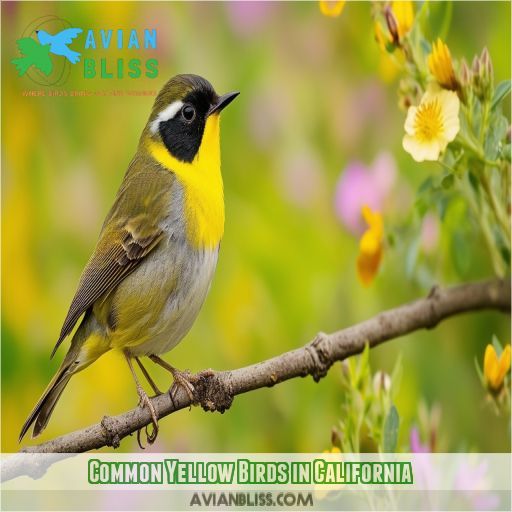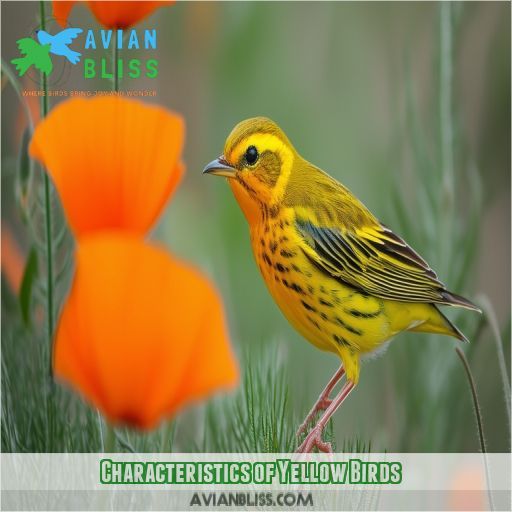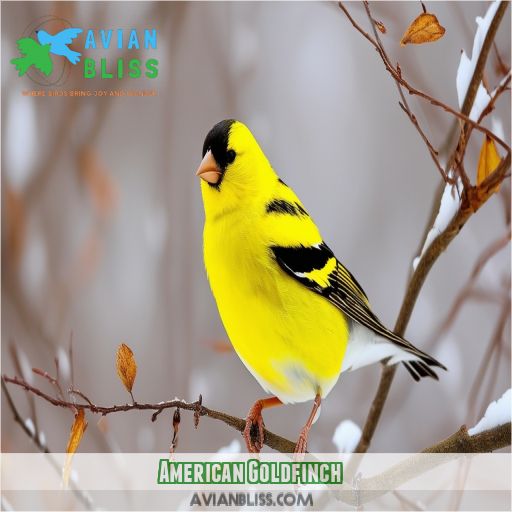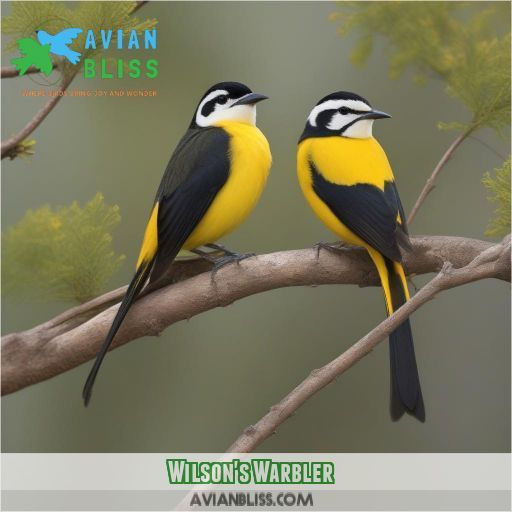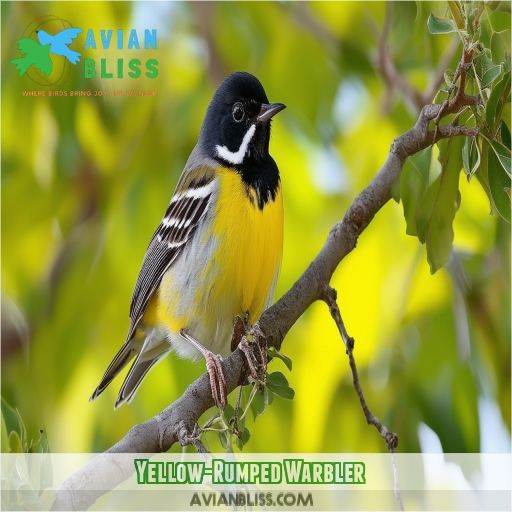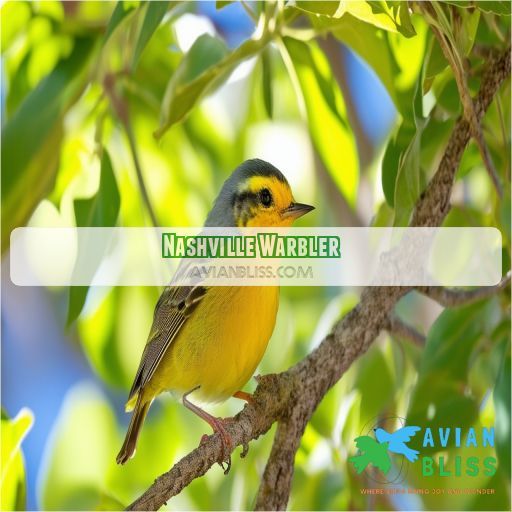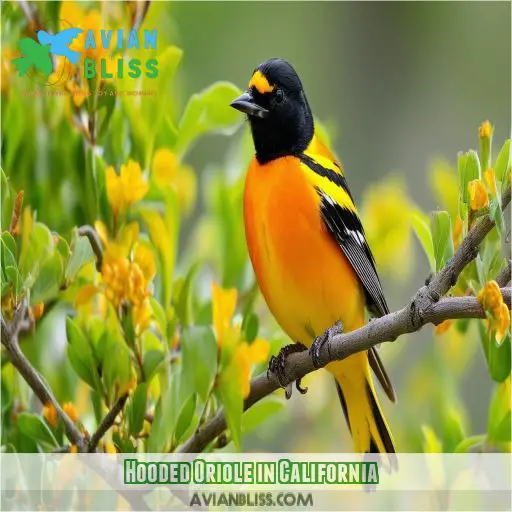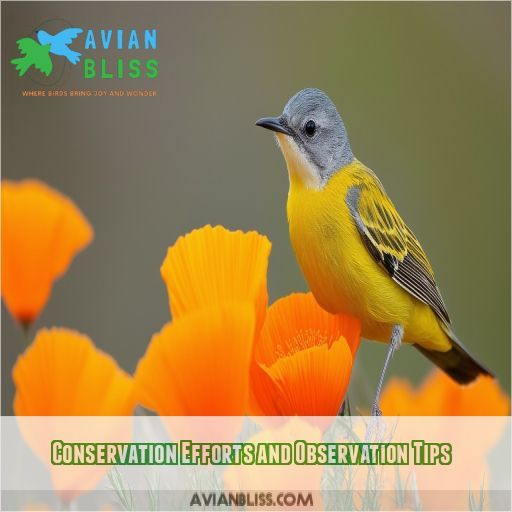This site is supported by our readers. We may earn a commission, at no cost to you, if you purchase through links.
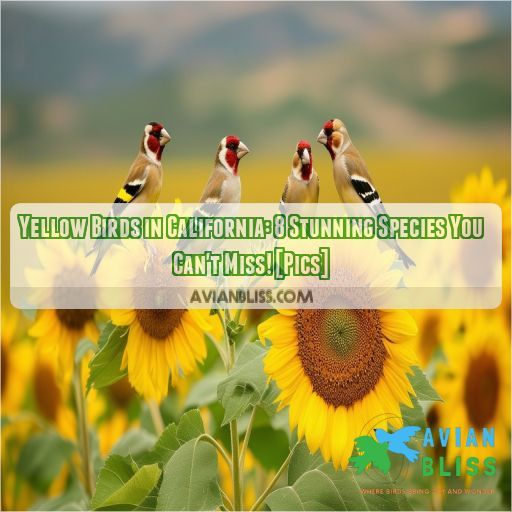 Ironically, the most vibrant wildlife in the Golden State isn’t golden at all.
Ironically, the most vibrant wildlife in the Golden State isn’t golden at all.
California’s landscapes are adorned with stunning yellow birds that’ll catch your eye.
You’ll discover eight species that stand out in the diverse ecosystems.
From the American Goldfinch to the Hooded Oriole, these feathered wonders offer a spectrum of yellows you can’t miss.
We’ll explore their unique characteristics, habitats, and behaviors, giving you the knowledge to spot and appreciate these colorful creatures in their natural settings.
Table Of Contents
- Key Takeaways
- Common Yellow Birds in California
- Characteristics of Yellow Birds
- American Goldfinch
- Yellow Warbler
- Lesser Goldfinch
- Wilson’s Warbler
- Yellow-Rumped Warbler
- Nashville Warbler
- Hooded Oriole in California
- Conservation Efforts and Observation Tips
- Frequently Asked Questions (FAQs)
- What are the yellow birds in California?
- What are the little yellow birds called?
- What is the most common yellow bird?
- What is a yellow bird that looks like a sparrow?
- How do yellow birds maintain their vibrant plumage colors?
- What role do yellow birds play in Californias ecosystems?
- Are there any yellow birds unique to California?
- How do climate changes affect yellow bird populations?
- What are the main predators of yellow birds?
- Conclusion
Key Takeaways
- California is a birder’s paradise, with a rainbow of yellow-feathered friends from coast to mountaintop – talk about a golden opportunity!
- These sunny songsters aren’t just pretty faces; they’re nature’s little helpers, pollinating plants and keeping pesky bugs in check.
- From the acrobatic American Goldfinch to the fashion-forward Hooded Oriole, each yellow bird has its own quirky personality and talents.
- You can roll out the welcome mat for these winged wonders by creating bird-friendly spaces in your backyard – who knows, you might just become the hottest bird hangout in town!
Common Yellow Birds in California
You’re in for a treat when it comes to yellow birds in California!
The Golden State‘s diverse habitats are a haven for these vibrant creatures.
From coastal areas to mountain ranges, you’ll find an array of yellow-feathered friends flitting about.
Keep your eyes peeled for the cheerful Yellow Warbler, often spotted near streams and wetlands.
The American Goldfinch, with its bright lemon hue, is a common sight at backyard feeders.
Don’t miss the Lesser Goldfinch, a smaller cousin that’s equally charming.
For a splash of color, look out for the Western Tanager, sporting a striking yellow body with red head.
The Black-headed Grosbeak, while not entirely yellow, adds a touch of golden to its striking plumage.
These species contribute to California’s rich avian diversity, offering birdwatchers a golden opportunity for exciting sightings.
Characteristics of Yellow Birds
You’ll notice that yellow birds in California exhibit a wide range of plumage and markings, from vibrant solid yellows to intricate patterns with contrasting colors. Their behavior and habits vary greatly among species, with some preferring open fields while others thrive in dense forests or urban environments.
Plumage and Markings
You’ll be captivated by the stunning plumage of California’s yellow birds. Their vibrant feathers come in a dazzling array of patterns and color variations, making each species truly unique. As you explore the avian world, you’ll encounter:
- Bright lemon-yellow bodies with contrasting black wings
- Subtle olive-green hues blending into golden-yellow bellies
- Bold black caps atop sunny yellow heads
- Distinctive wing bars and tail spots adding visual interest
These eye-catching combinations aren’t just for show; they play key roles in attracting mates and camouflage. The more you observe, the more you’ll appreciate the intricate beauty of these feathered wonders.
Behavior and Habits
You’ll find that yellow birds in California aren’t just eye-catching; their behavior is equally fascinating.
Listen closely, and you’ll hear their melodious songs echoing through their habitats.
Watch as they expertly build nests, showcasing their architectural skills.
During feeding time, you’ll spot them foraging for seeds and insects with precision.
Their migration patterns are a clear sign of their resilience, with some species traveling thousands of miles.
American Goldfinch
You’ll find the American Goldfinch’s vibrant yellow plumage hard to miss as it flits through California’s open woodlands and fields. This small finch, with its distinctive black wings and white wing bars, can be spotted year-round in the state, though its bright breeding colors are most visible during spring and summer.
Physical Description
You’ll be captivated by the American Goldfinch’s vibrant yellow plumage. These small, finch-shaped birds sport a striking black cap and wings with white markings. Males boast a brilliant lemon-yellow body, while females display a more subdued olive-yellow. Their compact size and conical bills make them easily recognizable among California’s yellow bird species.
Habitat and Range
You’ll find American Goldfinches across California, from coastal areas to mountain meadows. They’re adaptable birds, thriving in open woodlands, gardens, and fields. During spring and summer, they’re widespread across the state. Come winter, some migrate south, while others stick around in milder regions. Keep an eye out for these vibrant birds in your neighborhood!
Behavior and Diet
You’ll often spot American Goldfinches flitting about, their cheerful songs filling the air. These yellow birds are seed eaters extraordinaire, favoring thistle and sunflower seeds. They’re not shy about visiting bird feeders, making them a backyard favorite that thrives on the right bird feeder setup
. During breeding season, they’ll supplement their diet with insects for extra protein.
Yellow Warbler
You’ll easily identify the Yellow Warbler by its bright yellow plumage and rusty streaks on the chest. These cheerful songbirds build cup-shaped nests in shrubs or small trees, often near water sources, and you can attract them to your backyard by planting native berry-producing shrubs and maintaining a water feature.
Appearance and Identification
You’ll be mesmerized by the Yellow Warbler‘s vibrant plumage. Their lemon-yellow bodies, often adorned with chestnut streaks, make identification a breeze. Males sport brighter hues than females, but both showcase stunning patterns. Keep an eye out for these eye-catching birds:
- Brilliant yellow feathers that catch the sunlight
- Delicate chestnut streaks on males’ chests
- Subtle olive tints on wings and back
- Distinctive black eyes that contrast with their yellow faces
These charming warblers stand out among California’s goldfinches and yellow-breasted chats.
Nesting and Reproduction
You’ll find Yellow Warblers’ nesting habits fascinating. These vibrant birds build cup-shaped nests in shrubs or small trees, often near water. Their reproductive cycle is a marvel of nature:
| Stage | Duration | Description |
|---|---|---|
| Egg-laying | 4-5 days | 3-6 eggs laid |
| Incubation | 11-12 days | Female-dominated |
| Nestling | 8-10 days | Both parents feed |
| Fledgling | 2-3 weeks | Parents still care |
Conservation and Backyard Tips
You can help conserve Yellow Warblers by creating bird-friendly spaces in your backyard. Set up diverse feeder types and plant native shrubs to attract these vibrant visitors. As habitat loss threatens California wildlife, your efforts make a difference. Join local conservation groups and participate in birdwatching activities to support these stunning summer residents and their pine warbler cousins.
Lesser Goldfinch
You’ll find the Lesser Goldfinch to be a small but striking yellow bird with distinctive black wings and cap. This species thrives in open woodlands and gardens across California, where it’s known for its acrobatic feeding habits and cheerful song.
Physical Characteristics
You’ll be amazed by the Lesser Goldfinch‘s striking appearance. These beautiful yellow birds, common in San Diego’s diverse landscapes, boast vibrant plumage with unique patterns. Their compact size and sleek shape make them a delight to spot. Males flaunt bright yellow bellies with black caps, while females display more subdued olive-green hues. Don’t confuse them with the Hooded Warbler!
Habitat and Behavior
You’ll find Lesser Goldfinches in a variety of open habitats, from gardens to woodland edges. They’re social birds, often flocking together and chattering away. These tiny yellow dynamos love to feast on seeds, especially thistle. During breeding season, they’ll build cup-shaped nests in trees or shrubs. Keep an eye out for their acrobatic feeding displays!
Interaction With the Environment
You’ll find Lesser Goldfinches interacting with their environment in fascinating ways. These adaptable birds thrive in various habitats, impacting ecosystems through their behaviors. Here’s how they interact:
- Seed dispersal through feeding habits
- Pollination while foraging for nectar
- Nest building using local materials
- Adapting to climate change impacts
Their presence often attracts other species like American Redstarts and White-eyed Vireos, creating diverse bird communities.
Wilson’s Warbler
As you continue your exploration of yellow birds in California, you’ll want to keep an eye out for the charming Wilson’s Warbler. This tiny songbird is a vibrant addition to the state’s avian palette, with its bright yellow plumage and distinctive black cap on males. You’ll often spot these lively creatures flitting through dense undergrowth or low-hanging branches in moist woodlands and riparian areas.
Wilson’s Warblers are insectivores, expertly catching their prey on the wing or gleaning them from leaves. Their diet consists mainly of small insects and spiders, which they hunt with impressive agility. During migration, you might see them in mixed flocks with other warblers and small songbirds.
In California, Wilson’s Warblers are primarily summer residents, arriving in spring to breed before heading south for the winter. Their cheerful "chit-chit-chit-chit" song is a delightful addition to the forest soundscape. Keep your ears open – you might hear one before you see it!
Yellow-Rumped Warbler
You’ll easily spot the Yellow-rumped Warbler by its distinctive yellow rump patch and gray plumage with black streaks. This adaptable species is known for its varied diet, including insects, berries, and seeds, and it’s one of the few warblers that can digest the waxes found in bayberries and wax myrtles.
Appearance and Features
You’ll be amazed by the Yellow-Rumped Warbler’s distinctive appearance. Its gray body contrasts beautifully with vibrant yellow patches on the rump, sides, and crown. These unique patterns and markings make it a standout among California’s yellow birds.
Here are three key features to look for:
- Bold yellow rump patch
- Black chest streaks
- White throat and wing bars
Feeding Behavior
You’ll be amazed by the Yellow-rumped Warbler’s diverse foraging habits. These adaptable birds are true culinary adventurers, switching their diet with the seasons. From insect-hunting acrobatics to seed-eating frenzies, they’ve got it all covered. Check out their feeding preferences:
| Season | Primary Food | Foraging Technique |
|---|---|---|
| Spring | Insects | Aerial flycatching |
| Summer | Fruits | Tree canopy gleaning |
| Fall | Seeds | Ground foraging |
Interaction With Humans
You’ll often encounter Yellow-rumped Warblers in urban areas during their migration. These adaptable birds have embraced human-altered landscapes, making birdwatching a breeze. Here’s how they interact with us:
- Frequent backyard feeders, especially in winter
- Thrive in parks and gardens, adapting to urbanization
- Provide natural pest control by eating insects
Their habits make them perfect companions for city dwellers and nature enthusiasts alike.
Nashville Warbler
You’ll easily identify the Nashville Warbler by its distinctive gray hood and bright yellow underparts. This small warbler is known to interact with other species by joining mixed-species foraging flocks, often associating with chickadees, titmice, and kinglets during migration and in winter.
Physical Appearance
You’ll be captivated by the Nashville Warbler’s unique appearance.
This small songbird sports a vibrant yellow plumage that’ll catch your eye in an instant.
Its olive-green back contrasts beautifully with its bright yellow underparts.
The most distinctive feature? A striking gray hood that covers its head and neck.
Look closely, and you’ll spot a white eye ring that seems to pop against the gray.
Males and females share similar markings, but males often display slightly brighter colors.
It’s a true gem among California’s yellow birds!
Interaction With Other Species
You’ll often find Nashville Warblers interacting with a diverse array of species in their California habitats.
During nesting season, they’re fiercely territorial, chasing away potential competitors.
But in terms of foraging, they’re more sociable. You might spot them in mixed flocks with chickadees and kinglets, a behavior that increases their chances of finding food and spotting predators.
These warblers have a unique symbiosis with porcupines – they use their quills as bedding material!
This clever adaptation showcases their ability to thrive through unexpected interactions in their ecosystem.
Hooded Oriole in California
You’ll be amazed by the striking Hooded Oriole, a vibrant yellow bird with a distinctive black throat and face mask. These slender beauties build unique hanging nests on palm fronds and can often be spotted sipping nectar from hummingbird feeders in California’s southwestern regions.
Identification and Appearance
After exploring the Nashville Warbler, let’s turn our attention to the striking Hooded Oriole.
You’ll be captivated by its vibrant yellow plumage and distinctive black markings.
Males sport a bright orange-yellow body with a black throat and face, resembling a hood.
Females, while more subdued, still showcase beautiful lemon-yellow feathers.
Don’t miss their slender, curved bills – perfect for probing flowers and fruit.
These eye-catching birds stand out among California’s avian residents, their colors rivaling the golden sunshine of the Golden State itself.
Behavior, Diet, and Nesting
You’ll find Hooded Orioles‘ behavior fascinating.
These yellow birds are slow, deliberate foragers, often hanging upside down to snatch insects or sip nectar.
They’re not shy about visiting your hummingbird feeders!
Their diet includes fruit, nectar, and insects.
When it comes to nesting, they’re true artists.
Females "sew" hanging nests under palm fronds, creating a cozy home for their chicks.
Listen closely, and you might hear their chattering calls or even their impressive mimicry of other birds.
Their unique habits make them a joy to observe in your backyard.
Conservation Efforts and Observation Tips
As you’ve learned about the vibrant yellow birds of California, you might wonder how to contribute to their conservation while enjoying their beauty. Birdwatching isn’t just a hobby; it’s a gateway to citizen science and conservation impact. You can make a difference by:
- Participating in local bird counts and surveys
- Creating bird-friendly habitats in your backyard
- Using native plants to attract and support local bird species
- Avoiding pesticides and harmful chemicals in your garden
Set up bird feeders to attract these golden beauties, but remember to clean them regularly to prevent disease spread. Consider joining a local Audubon Society chapter to connect with fellow bird enthusiasts and learn more about conservation efforts. By observing and reporting bird sightings, you’re contributing valuable data to researchers studying population trends and migration patterns. Your backyard can become a haven for yellow birds, providing them with food, water, and shelter. With these simple steps, you’re not just watching birds; you’re actively participating in their protection and survival.
Frequently Asked Questions (FAQs)
What are the yellow birds in California?
You’ll spot several yellow birds in California, including American Goldfinches, Yellow Warblers, and Western Tanagers. These vibrant species thrive in diverse habitats, from coastal areas to forests. Look for their distinctive markings and listen for their melodious songs.
What are the little yellow birds called?
Like sunbeams flitting through the trees, those little yellow birds are nature’s gems. You’ll spot American Goldfinches, Yellow Warblers, and Lesser Goldfinches. They’re small songbirds that brighten your day with their vibrant plumage and cheerful melodies.
What is the most common yellow bird?
You’ll find the American Goldfinch is the most common yellow bird. They’re abundant across North America, flitting through fields and gardens. Their bright plumage and cheerful song make them easy to spot and beloved by birdwatchers everywhere.
What is a yellow bird that looks like a sparrow?
Like a feathered Cinderella at the ball, the American Goldfinch might catch your eye. You’ll spot this sparrow-sized beauty with its vibrant yellow plumage and black wings. It’s a common sight at feeders, especially those offering sunflower seeds.
How do yellow birds maintain their vibrant plumage colors?
You’ll find yellow birds maintain their vibrant plumage through specialized diet and preening. They consume carotenoid-rich foods, like insects and berries, and distribute oils from their preen gland to enhance feather color and waterproofing. It’s nature’s own beauty regimen!
What role do yellow birds play in Californias ecosystems?
Did you know that California’s yellow birds pollinate over 1,000 plant species? You’ll find these vibrant flyers playing key roles in seed dispersal, pest control, and maintaining biodiversity. They’re nature’s little helpers, keeping ecosystems in balance.
Are there any yellow birds unique to California?
While California boasts diverse yellow birds, none are strictly endemic. You’ll find unique subspecies, like the "California" Yellow Warbler, but they’re not exclusive to the state. Many yellow birds here are widespread across North America.
How do climate changes affect yellow bird populations?
While some birds thrive, others struggle. You’ll notice climate change impacts yellow bird populations through altered migration patterns, breeding times, and food availability. It’s a delicate balance that you’re witnessing unfold in real-time.
What are the main predators of yellow birds?
You’ll find that yellow birds face threats from various predators. Cats, hawks, and snakes are common culprits, while larger birds like jays and crows often raid nests. Even squirrels can pose a danger to eggs and nestlings.
Conclusion
While California’s golden hills may dazzle, it’s the vibrant yellow birds that truly captivate.
You’ve now explored eight stunning species, from the American Goldfinch to the Hooded Oriole, each with unique characteristics and behaviors.

